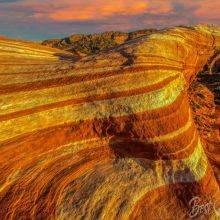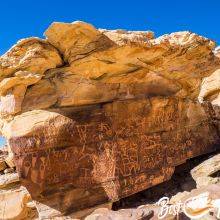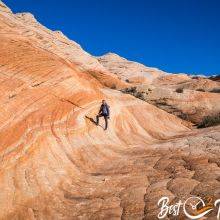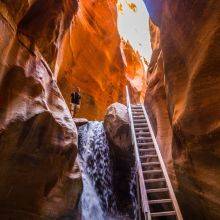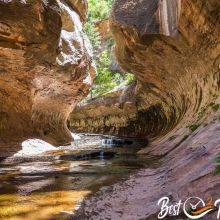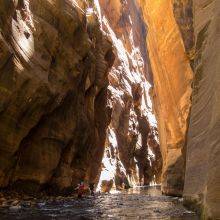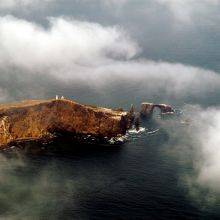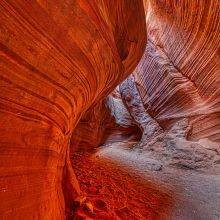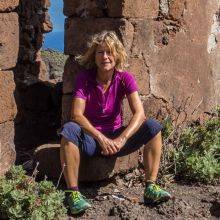When Is the Best Time
The Death Valley is an extreme place but fascinating as well. Except for summer, stay here at least a night. Watch the beautiful night sky without any light pollution. Death Valley is certified as the largest Dark Sky National Park in the US.
The best time to visit Death Valley is the colder time of the year, from November to March. The winter months are chilly; minus degrees occur in the night, but it is hardly crowded. It is extremely hot during the day from May to September; only early morning and evening are pleasant. The summer from July to September is also the busiest time with many visitors from Europe.
If you want to climb up the dunes in the summer, do the hike before sunrise to avoid the heat of the day and enjoy the magnificent atmosphere. That way, you'll also dodge the crowds during the day. Another great time in the valley is the sunset, of course.
Weather and Seasons in the Death Valley
Four mountain ranges are situated between the ocean and the Death Valley. Due to the rainshadow effect, very few precipitations reach the hot desert. Badwater Basin in the Death Valley has the lowest elevation of 282 feet/86 m below sea level in North America. The air in the valley heats up but is captured like in a cauldron and gets reheated. These geological conditions generate a hot desert climate. The summer is boiling, the winter mild and pleasant though nights are chilly. There is rainfall on average on 20 days annually. Sunny skies are common, but occasionally a winter storm or a summer thunderstorm cover the sky in clouds.
Winter (December-February)
The winter is a lovely time to travel to Death Valley. It is the best time for hiking under the strong Californian sun. The average daily temperatures range from 10°C-20°C/50°F-68°F. Bring a jacket or fleece pullover for the day. Nights are cold, ranging on average from 3°C-8°C /37°F-46°F. Higher elevations in the valley like Telescope Peak experience snow. Precipitation occurs during this time of the year, but it is more an exception with just 2.2 inches of annual rainfall.
Spring (March-April)
Usually, March and April are pleasant times for hiking, but it can also already start to become warm. Temperatures are fluctuating between 13°C-27°C/55°F-81°F in March and 17°C-32°C/63°F-90°F in April. Wildflowers can occur in abundance, but it depends on the amount of rainfall in the winter. The wind is common in the Death Valley, especially in spring. Dust storms can occur suddenly. During the spring break, Death Valley gets utterly busy.
Summer (May-September)
Death Valley is one of the hottest places in the world. If you plan to travel through the Death Valley during this time of the year, you know afterwards, that's true. We drove through the valley in May, seeking shelter at midday. Be prepared for day temperatures ranging from 30°C-45°C/86°F-113°F in the shade and even higher. The dry heat is brutal to stand without air-conditioning. Thunderstorms can happen and cause flooding. However, the average annual rainfall is just 2.2 inches.
August 2021:
This summer was one of the hottest ever in Death Valley, reaching more than 127°F /53°C. Two hikers already died in Death Valley in the summer 2021. Limit hiking to the cooler morning hours and end your walk latest at 10 am. Carry plenty of water and salty snacks with you. Do not underestimate the heat!
Autumn (October-November)
Temperatures decrease ranging on average from 17°C-25°C/63°F-77°F but can top 30°C/86°F as well. The hiking and camping season starts in October; however, still avoid the midday heat. Night temperatures ranging from 17°C-9°C/63°F-48°F. These months are not crowded except for Veterans Day week in November.
Best Months to Visit
Location and Tips

At Mesquite, Flat Sand Dunes is no trail to follow; just explore this beautiful place on your own. Watch the sun come up and paint the dunes, enjoy the peace and silence and surround yourself with pure nature.
We stayed in Furnace Creek in the Inn at Death Valley because of the excellent location inside the National Park. It is pretty expensive here, especially gasoline. There are very few gas stations, therefore, have a full tank and keep an eye on your gas display while driving through the Death Valley. Even outside the park boundaries, gas stations are rare.
7 Must-Know Tips
- For taking photos without footprints, get there early or walk further during the day.
- Excellent for stunning sunrise or sunset photos.
- A perfect spot for stargazing in Death Valley.
- It is less busy the further you walk from the car park.
- It's easily accessible from Hwy. 190 and a short drive from the Furnace Creek Visitor Center.
- There aren't any facilities here.
- Always watch your gas. There are very few gas stations in the park and outside the park boundaries.
5 Highlights in the Death Valley
- Mesquite Flat Dunes
This place is a photographers dream. If possible, watch the sunrise or sunset at the breathtaking dunes. - Badwater Basin
The lowest point of North America, 282 feet/86 m below sea level with its salt flats, is a Must visit. Take a short walk of roughly 2 mi for spectacular views and pictures as well. - Zabriskie Point
Located near Furnace Creek on the way to Dante's View. Like the entire Death Valley, another fascinating spot where extremes are normal. It's a short walk from the huge car park to the viewpoint. Everybody stops at the colourful Zabriskie Point, one of the busiest places throughout the day except early morning and evening. - Dante's View
It's roughly half an hour drive from the Furnace Creek Ranch. The last miles are climbing up in serpentines to an elevation of almost 5577feet/1.700 m. It's a stunning view from here down to Death Valley. It's definitely, a Must visit. - Devil's Golf Course
Such a surreal place in the Death Valley covered by an evaporated lake thousand of years ago. "Only the devil could play golf here" this area couldn't be described better.
These wonderful pictures were taken by my friends "Umamisky". I visited the Death Valley once in May, which was already unbearable hot.



































